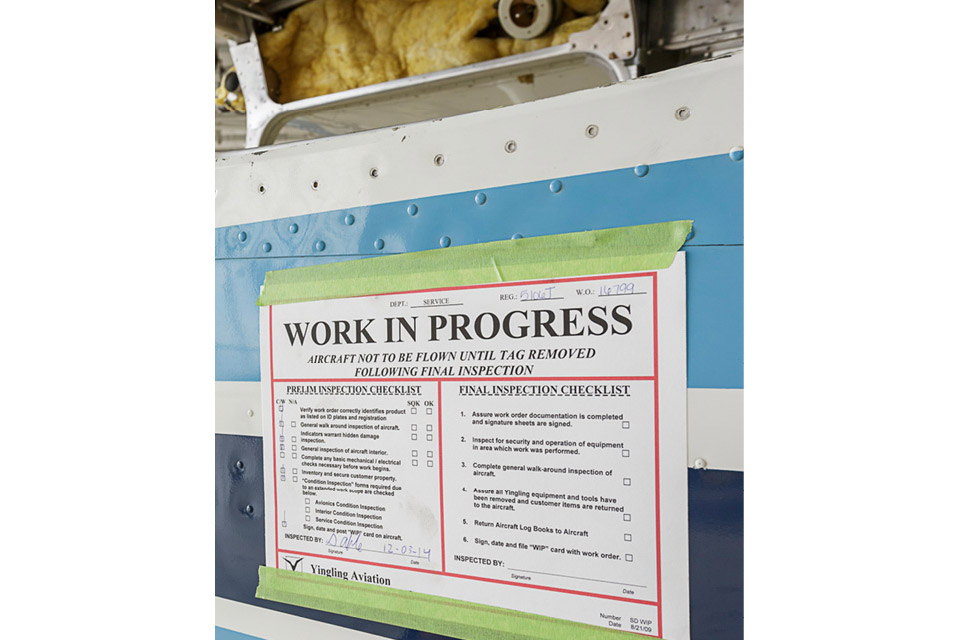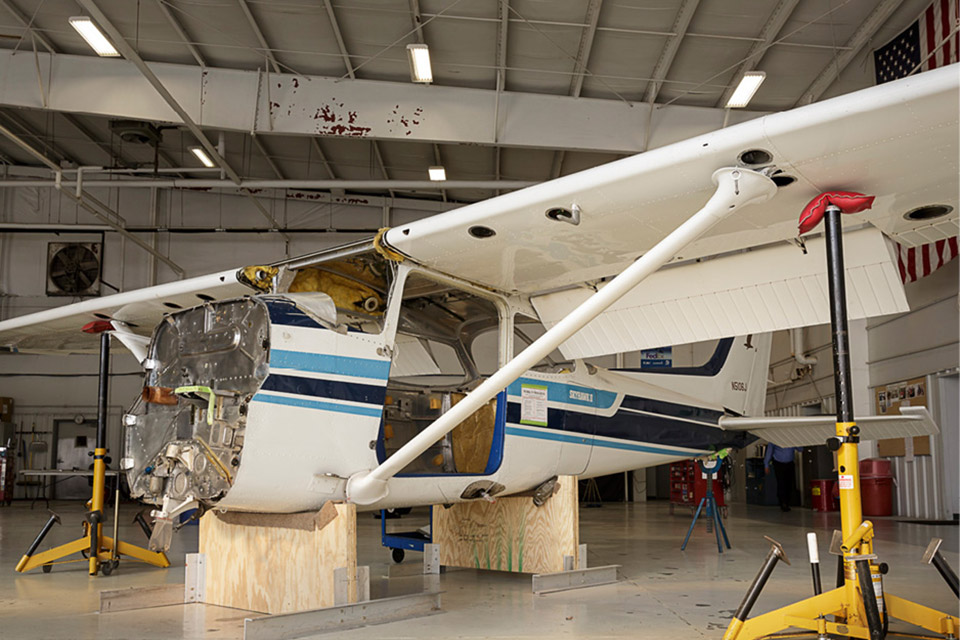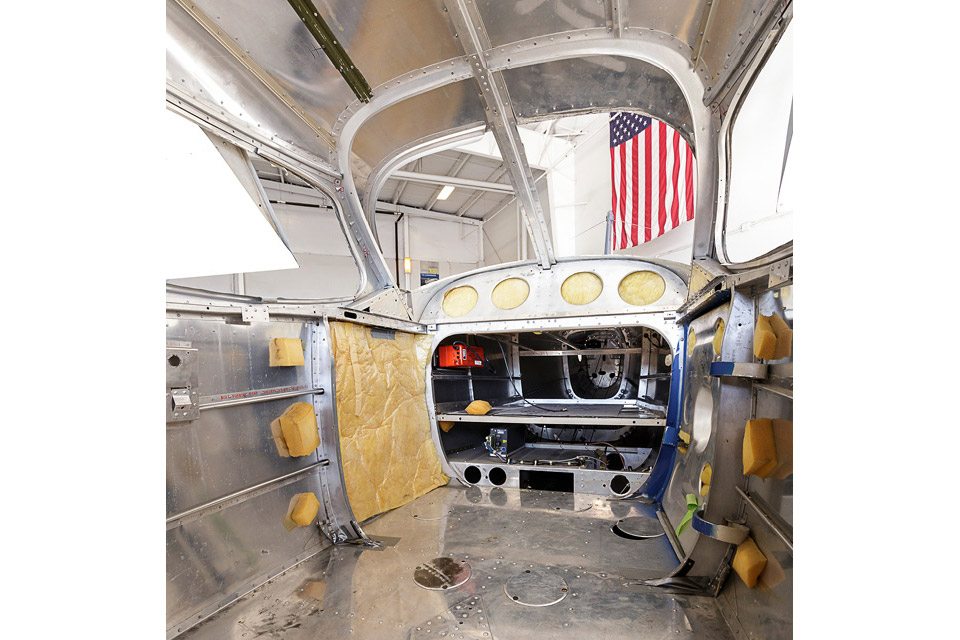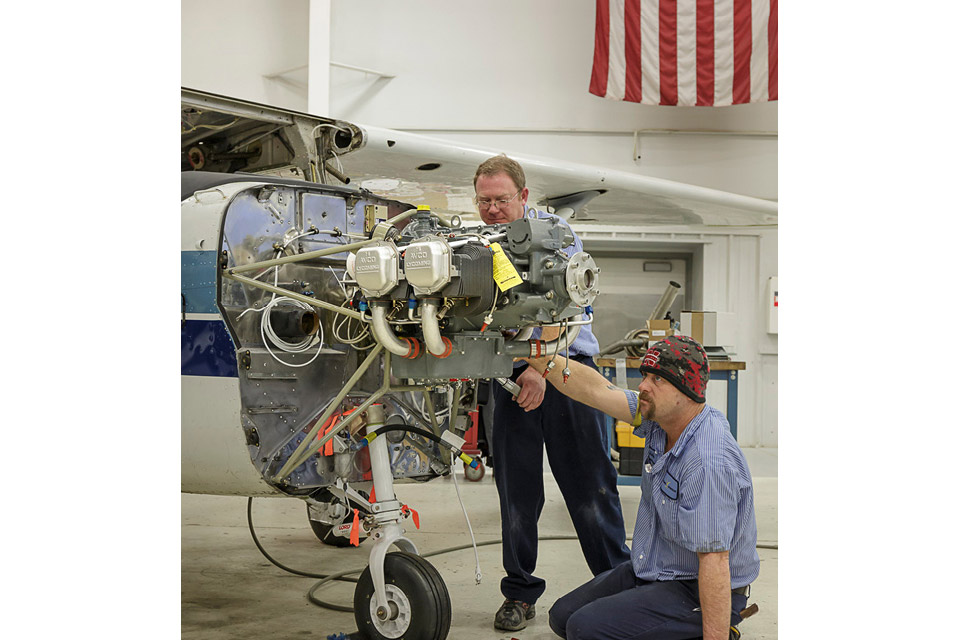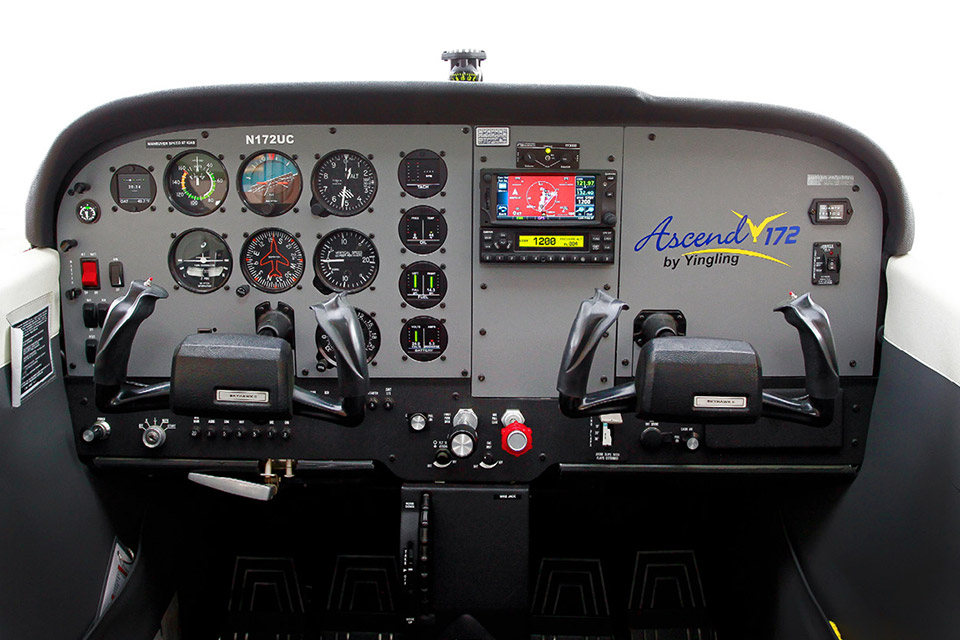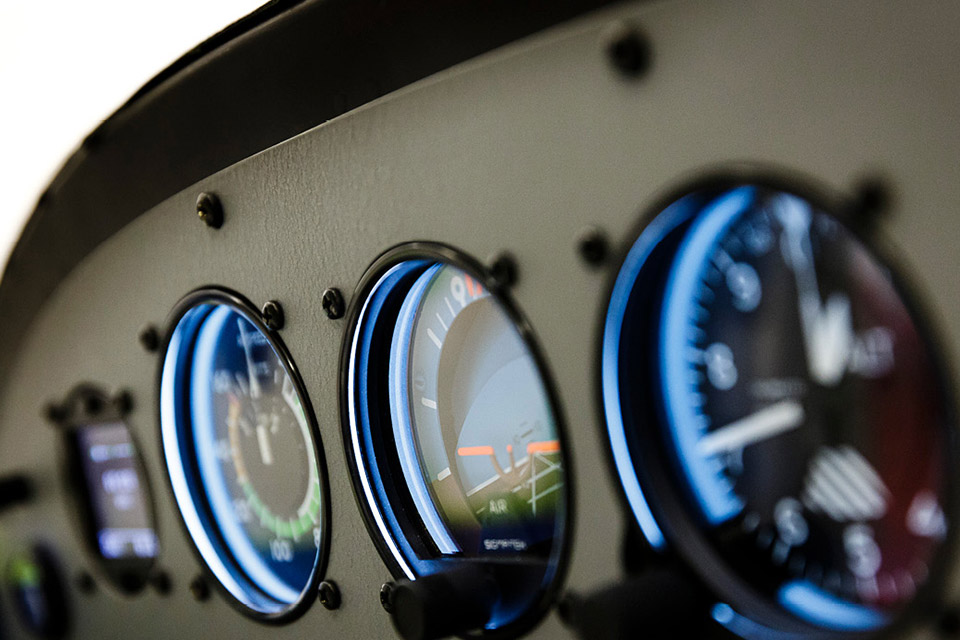Reborn in the U.S.A.
Bring your tired, your weary 172s to Wichita for a total makeover
Airplane number 4 is parked in a maintenance hangar at Yingling Aviation in Wichita, Kansas, resembling something a model airplane builder started and then forgot about. Everything from the firewall forward is gone. The fuselage sits on blocks. In the torn-up cabin, a Yingling technician is stripping out avionics from the 1977 Cessna 172N’s panel.
It’s hard to visualize what brand-new number 4 looked like when it rolled out of the Cessna factory. But when Yingling has signed off on the final logbook entry, this faded bird will be as close to new as is possible—and it will sport some improvements that 1970s-era aircraft manufacturers could not have envisioned.
Number four is getting an inside-out, top-to-bottom restoration through Yingling’s Ascend 172 initiative. Launched in summer 2015, Ascend is Yingling’s response to the aviation industry’s growing effort to transform legacy airframes into like-new airplanes that can be sold at a much lower price.
“We need to get more people to learn how to fly for the overall health and benefit of our industry,” Yingling Chairman and Chief Executive Officer Lynn Nichols said. “One way you do that is to drive the cost down.” The intent of the initiative, he said, is to reduce the cost and still come up with a product that almost equally matches a new aircraft, “and that’s what we’re trying to do,” he said.
Yingling is uniquely positioned to bring old Cessnas to modern standards. Established in 1946, the company is one of Cessna’s oldest partners; its founder, Vic Yingling Jr., sold Cessna 120s and 140s out of his father’s Chevrolet dealership in downtown Wichita. Today, Yingling is the largest Cessna parts dealer in the world. Its maintenance, interior, avionics, and propeller shops collectively service hundreds of airplanes a year.
Yingling is wrapping up a five-year contract with FedEx that involved retrofitting 230 Cessna Caravans with Garmin G600s, removing anti-ice boots, and installing TKS ice protection systems.
“What we’ve learned from that is how do you modify an aircraft multiple times, doing the same thing over and over again—knowing each aircraft is a little unique and different in terms of condition?” Nichols said.
N for almost new
Cessna number 4 is the fourth airplane to get an Ascend makeover.
Cessna number 1 is in Frederick, Maryland. Sporting a bright yellow paint scheme, N172UC is leased to AOPA. Number two has been completed and sits on display at Yingling with “For Sale” banners on its propeller. Number three is in a Kansas paint shop getting its new livery. Numbers five and six sit alongside number 4, patiently awaiting their transformations.
The process starts with a 172N airframe. The N model was chosen for specific reasons, among them the fact that there are more in the field than any other variant.
“If you look at the production run of the 172, it was the N that [Cessna] produced the most of,” said Jerry Pickett, vice president of customer programs at Yingling. “Ns had the first production of the 160-horsepower engine. It’s a stable platform.”
Other considerations: 40-degree flaps and numerous supplemental type certificates that can offer additional options to owners. “There’s a lot of potential in that airframe that there was not in others,” Pickett said. Finally, the N’s 14-volt electrical system means owners won’t need a specialized ground power unit, and batteries are less expensive.
Each airframe undergoes an exhaustive inspection for firewall damage and corrosion. Yingling President Lonnie Vaughan said the company has been pretty choosy in selecting airframes for the Ascend program. There were nonstarters, including a 172 that had been on its back—twice—although the owner claimed his shop did a really good job of fixing it.
“We work to buy the nicest,” Vaughan said. “We’re looking for no damage history, complete logbooks,” or, if there has been damage, older damage that has been repaired.
Purchasing airframes from dry regions, including Kansas and Oklahoma, corrosion has been minimal, Pickett said.
Top to bottom
The Lycoming O-320 is sent to Custom Airmotive in Tulsa, Oklahoma, for overhaul and dynomometer testing. Engine trusses are inspected and rebuilt as needed—and it’s usually needed. Every aircraft acquired for the Ascend program has presented cracked engine trusses, said Steve J. Draher, project manager at Yingling.
The engine mount, muffler, tail pipe, and engine baffling are replaced with new components. The cowling is rebuilt and installed with new shock mounts and hardware.
The overhauled engine gets a brand-new starter, alternator, vacuum pump, and voltage regulator.
The propeller is overhauled, painted, and balanced at Yingling’s propeller shop, which itself recently moved into a brand-new facility just two blocks from the company’s headquarters at Wichita Dwight D. Eisenhower National Airport.
New and improved
An Ascend 172 has that new car—or new airplane—aroma: The cockpit and cabin transformation includes all-new glareshield, headliner, side panels, seats, and carpeting. Seats are inspected, and those cranky seat tracks are replaced or rebuilt as necessary.
New TSOed analog flight instruments are installed. Why not glass? To keep the cost down, Nichols said. What’s more, flight schools and potential customers who viewed an Ascend 172 at EAA AirVenture 2015 were appreciative of the analog instruments, he added. (If you really want a glass panel, Yingling will install one, but you’ll pay extra.)
While flight instruments remain traditional, say goodbye to bobbing, unreliable fuel indicators: All engine instruments are replaced with new Aerospace Logic digital instruments. Since the digital instruments are connected to analog sensors, the sensors are overhauled, too, so that they interact with the gauges correctly, Draher said.
Of course, the 1970s-era avionics (or whatever happens to be in the panel) are removed and replaced with new equipment. Depending on which package you choose, the airplane will be equipped with a Garmin GTR 225 communications radio (Standard VFR), a Garmin GNC 255A nav/com (Standard VFR Trainer), or a Garmin GTN 650 GPS/nav/com (Standard IFR). Each package includes a Garmin GTX 327 Mode C transponder, PS Engineering PM3000 intercom, and SIRS Navigator wet compass.
In response to feedback from flight schools, Yingling added overhead speakers so that flight instructors and student pilots can talk to each other in the cockpit. Because customers suggested it, the company also added noise filters to alternators to eliminate background noise caused by electrical interference.
All circuit breakers, wiring, and switches are replaced with new, along with the pitot-static and instrument air lines.
Fuselage facelift
Gone is the scratched or crazed Plexiglas that usually is characteristic of a 38-year-old airplane. Cabin doors and windows are replaced with new light-gray Plexiglas—the same that is used in new airplanes, according to Draher.
The airframe itself is inspected and signed off on all supplemental inspection document items.
The nose and landing gear are removed, cleaned, inspected, and rebuilt; new tires and tubes are installed, along with new brakes and brake hoses.
Flight controls are inspected and rebuilt if needed. Control cables are inspected, and control cable pulleys are replaced. Control surface attach hardware is replaced.
Then there are the myriad smaller tweaks.
Baggage door springs are rebuilt so the doors don’t open in flight. Door latches are overhauled and springs replaced so that doors won’t slam shut. Displaying a push rod curved in a way no push rod should be, Draher said it likely resulted from someone forcing the door. That, too, will be replaced.
Skybolt fasteners will be installed on the cowling so that it can be more easily removed and put back on.
Wingtip caps with cracks around the screws aren’t put back on the airplane, but are replaced with new caps.
“We ask ourselves, ‘Would a new airplane have it this way?’” Draher said.
The finishing touches: a new paint scheme, completed at Aircraft Refinishing Co. in Paola, Kansas.
When it returns to Wichita, Yingling installs PM Research’s clear protective erosion coating on leading edges, around keyholes, and any other place paint might chip.
The entire process takes about three months. Nichols said. Yingling will deploy all that has been learned from the FedEx contract to produce four aircraft a month, he said.
If the Ascend concept proves successful, Nichols said Yingling would consider trying it out on Cessna 185s, 310s, or Piper Cherokees or Comanches.
What’s the price tag?
What will you pay for an Ascend 172? Prices vary by package, as follows:
The base price for the Standard VFR package is $159,900. This includes Garmin GTR 225 com radio, Garmin GTX 327 Mode C transponder, PS Engineering PM3000 intercom, SIRS Navigator wet compass, and digital engine instruments.
The base price for the Standard VFR Trainer package is $163,860 and includes a Garmin GNC 255A nav/com, plus the aforementioned equipment.
The base price for the Standard IFR package is $175,068, and includes a Garmin GTN 650 GPS/nav/com, plus the aforementioned equipment.
Compare those prices to that of a brand-new Cessna 172—around $400,000 for an airplane that comes standard with a Garmin G1000 glass avionics suite, Yingling representatives said.
The Ascend will be attractive not only to flight schools and flying clubs, but also individual pilots who would love a virtually new aircraft but don’t have the budget for a new one, Nichols said. Financing and leasing options are available through Yingling.
“They’re so close to a new airplane,” Nichols said. “I think we’ve got the right product.”
Email [email protected]
Reimagination revival: Other manufacturers bringing airplanes back to life
Yingling Aviation’s Ascend 172 is the latest, but certainly not the only program aimed at freshening classic airframes to bring more affordable, almost-new aircraft to buyers.
Aviat Aircraft’s Reimagined 150 or 152 brings new life to Cessna 150 J, K, L, and M models with a Lycoming 0-200A engine, and all Cessna 152 models (1977 through 1982) with the Lycoming O-235 engine. The base price for the 150 is $89,900; the base price for the 152 is $99,900. Options include wheel pants, a Garmin GDL 39A avionics kit, and a rebuilt Lycoming engine (www.aviataircraft.com). AOPA will announce the winner of the Reimagined Sweepstakes in February.
Piper Super Cub owners can fly their airplanes to CubCrafters for a total restoration that the company says will make the airplane fly farther, stall slower, and land in a shorter distance than any other Super Cub. The rebuild is estimated to take eight to 10 weeks (www.cubcrafters.com/rebuilds). Similarly, American Legend Aircraft Co. says it can take any legacy Piper Cub or ragwing airframe and restore it to factory new. After acquiring the airframe, refurbishment costs can be estimated to be around $60,000, according to the company (www.legend.aero/shop/).
Sporty’s 172LITE, announced in December 2014, is a Cessna 172 with new avionics, interior, and an overhauled Lycoming O-320-DJ2 swapped out for the O-320-H2AD. The rear seats are removed to increase useful load. Sporty’s Academy rents the aircraft for $99 per hour, but a 172LITE can be purchased for a base price of $132,900 (www.sportys.com), with options available. –JWT
Want to own an Ascend? Stay tuned for AOPA’s next sweepstakes
Once we announce the winner of our Reimagined 152 Sweepstakes sometime in February, it’s time to get ready for our very next project—and we already know what it is.
AOPA’s 2016-2017 sweepstakes will give away a Yingling Ascend 172 to one lucky pilot. Between now and sometime in 2017, we’ll bring an Ascend to locations around the country. In between, we’ll bring you updates on the airplane, how it will be equipped, and what you can expect to see as the project unfolds.
Look for the Ascend at all of our 2016 regional fly-ins as well as Sun ‘n Fun in Lakeland, Florida, and EAA AirVenture in Oshkosh, Wisconsin. –JWT


